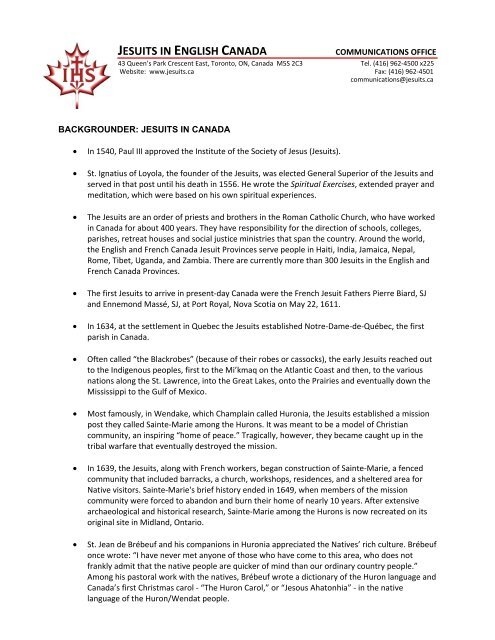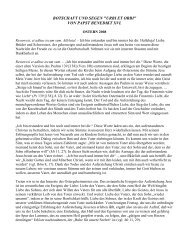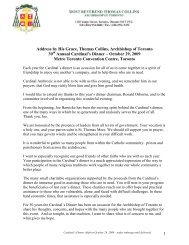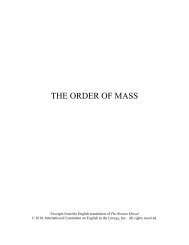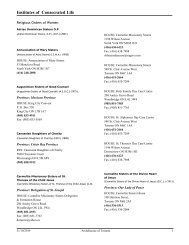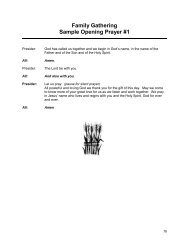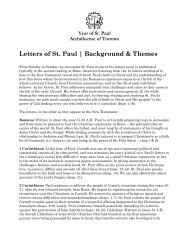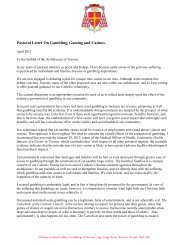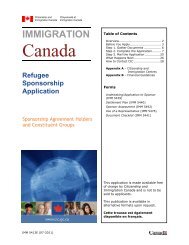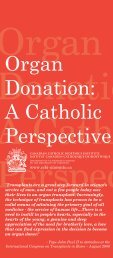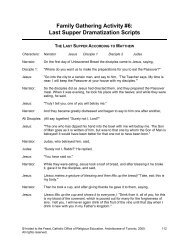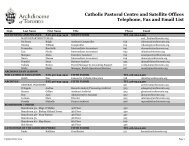JESUITS IN ENGLISH CANADA
JESUITS IN ENGLISH CANADA
JESUITS IN ENGLISH CANADA
Create successful ePaper yourself
Turn your PDF publications into a flip-book with our unique Google optimized e-Paper software.
<strong>JESUITS</strong> <strong>IN</strong> <strong>ENGLISH</strong> <strong>CANADA</strong><br />
COMMUNICATIONS OFFICE<br />
43 Queen’s Park Crescent East, Toronto, ON, Canada M5S 2C3 Tel. (416) 962‐4500 x225<br />
Website: www.jesuits.ca Fax: (416) 962‐4501<br />
communications@jesuits.ca<br />
BACKGROUNDER: <strong>JESUITS</strong> <strong>IN</strong> <strong>CANADA</strong><br />
<br />
<br />
<br />
<br />
<br />
<br />
<br />
<br />
<br />
In 1540, Paul III approved the Institute of the Society of Jesus (Jesuits).<br />
St. Ignatius of Loyola, the founder of the Jesuits, was elected General Superior of the Jesuits and<br />
served in that post until his death in 1556. He wrote the Spiritual Exercises, extended prayer and<br />
meditation, which were based on his own spiritual experiences.<br />
The Jesuits are an order of priests and brothers in the Roman Catholic Church, who have worked<br />
in Canada for about 400 years. They have responsibility for the direction of schools, colleges,<br />
parishes, retreat houses and social justice ministries that span the country. Around the world,<br />
the English and French Canada Jesuit Provinces serve people in Haiti, India, Jamaica, Nepal,<br />
Rome, Tibet, Uganda, and Zambia. There are currently more than 300 Jesuits in the English and<br />
French Canada Provinces.<br />
The first Jesuits to arrive in present‐day Canada were the French Jesuit Fathers Pierre Biard, SJ<br />
and Ennemond Massé, SJ, at Port Royal, Nova Scotia on May 22, 1611.<br />
In 1634, at the settlement in Quebec the Jesuits established Notre‐Dame‐de‐Québec, the first<br />
parish in Canada.<br />
Often called “the Blackrobes” (because of their robes or cassocks), the early Jesuits reached out<br />
to the Indigenous peoples, first to the Mi’kmaq on the Atlantic Coast and then, to the various<br />
nations along the St. Lawrence, into the Great Lakes, onto the Prairies and eventually down the<br />
Mississippi to the Gulf of Mexico.<br />
Most famously, in Wendake, which Champlain called Huronia, the Jesuits established a mission<br />
post they called Sainte‐Marie among the Hurons. It was meant to be a model of Christian<br />
community, an inspiring “home of peace.” Tragically, however, they became caught up in the<br />
tribal warfare that eventually destroyed the mission.<br />
In 1639, the Jesuits, along with French workers, began construction of Sainte‐Marie, a fenced<br />
community that included barracks, a church, workshops, residences, and a sheltered area for<br />
Native visitors. Sainte‐Marie's brief history ended in 1649, when members of the mission<br />
community were forced to abandon and burn their home of nearly 10 years. After extensive<br />
archaeological and historical research, Sainte‐Marie among the Hurons is now recreated on its<br />
original site in Midland, Ontario.<br />
St. Jean de Brébeuf and his companions in Huronia appreciated the Natives’ rich culture. Brébeuf<br />
once wrote: “I have never met anyone of those who have come to this area, who does not<br />
frankly admit that the native people are quicker of mind than our ordinary country people.”<br />
Among his pastoral work with the natives, Brébeuf wrote a dictionary of the Huron language and<br />
Canada’s first Christmas carol ‐ “The Huron Carol,” or “Jesous Ahatonhia” ‐ in the native<br />
language of the Huron/Wendat people.
Across the highway from Saint‐Marie is Martyrs’ Shrine which honours the eight Jesuit saints<br />
who worked among the Native people; St. Jean de Brebeuf, St. Gabriel Lalement, St. Isaac<br />
Jogues, St. Rene Goupil, St. Jean de Lalande, St. Antoine Daniel, and St. Noel Chabanel.<br />
The Jesuit Saints are the first saints from the northern New World to have been canonized.<br />
Often referred to as the “Canadian Martyrs,” they were put to death for their faith between<br />
1642 and 1649.<br />
The early Jesuits to Canada established celebrated educational institutions much like they had<br />
already done in Europe. For example, they founded the Collège‐des‐ Jésuites, today Université<br />
Laval.<br />
The Ratio Studiorum (the Jesuit Plan and Method of Studies) eventually became the model for 12<br />
Jesuit colleges and 15 Jesuit high‐schools spread across Canada from St. John’s to Edmonton.<br />
<br />
For more on the relationship of the Jesuits and Blessed Kateri, see Kateri Backgrounder.


